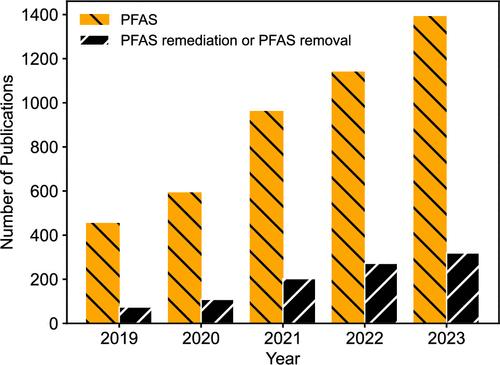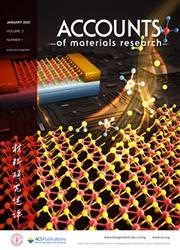Computational Design of Sorbent Materials for Per- and Polyfluoroalkyl Substances (PFAS) Remediation
IF 14
Q1 CHEMISTRY, MULTIDISCIPLINARY
引用次数: 0
Abstract
Figure 1. Number of publications from 2019 to 2023 found on Web of Science by searching PFAS-related keywords. Figure 2. Schematic of potential design parameters (e.g., thickness, surface roughness, nanoconfinement, and surface functionalization) for sorbent materials for PFAS adsorption and removal. Boran Ma is an Assistant Professor in the School of Polymer Science and Engineering at the University of Southern Mississippi. Prior to starting her independent career in January 2023, she was a postdoctoral associate at Duke University. She received her PhD in Materials Science and Engineering from Northwestern University in 2019 and her BEng in Materials Science and Engineering from Harbin Institute of Technology in 2014. The Ma Research Lab focuses on computation- and data-driven research of polymeric materials and systems for energy and sustainability applications. The author thanks the Director of the School of Polymer Science and Engineering, the Dean of the College of Arts and Sciences, and the Vice President for Research, all at the University of Southern Mississippi, for their support with generous start-up funds. This article references 15 other publications. This article has not yet been cited by other publications. Figure 1. Number of publications from 2019 to 2023 found on Web of Science by searching PFAS-related keywords. Figure 2. Schematic of potential design parameters (e.g., thickness, surface roughness, nanoconfinement, and surface functionalization) for sorbent materials for PFAS adsorption and removal. This article references 15 other publications.

用于全氟和多氟烷基物质 (PFAS) 修复的吸附剂材料的计算设计
图 1.通过搜索 PFAS 相关关键词在 Web of Science 上找到的 2019 年至 2023 年的出版物数量。图 2.用于吸附和去除 PFAS 的吸附剂材料的潜在设计参数(如厚度、表面粗糙度、纳米细化和表面功能化)示意图。Boran Ma 是南密西西比大学高分子科学与工程学院的助理教授。在 2023 年 1 月开始独立工作之前,她是杜克大学的博士后助理。她于2019年从西北大学获得材料科学与工程博士学位,并于2014年从哈尔滨工业大学获得材料科学与工程学士学位。马研究实验室专注于计算和数据驱动的聚合物材料和系统在能源和可持续发展方面的应用研究。作者感谢南密西西比大学高分子科学与工程学院院长、文理学院院长和主管科研的副校长提供的慷慨启动资金。本文引用了 15 篇其他出版物。本文尚未被其他出版物引用。图 1.通过搜索 PFAS 相关关键词在 Web of Science 上找到的 2019 年至 2023 年的出版物数量。图 2.用于吸附和去除 PFAS 的吸附剂材料的潜在设计参数(如厚度、表面粗糙度、纳米细化和表面功能化)示意图。本文引用了 15 篇其他出版物。
本文章由计算机程序翻译,如有差异,请以英文原文为准。
求助全文
约1分钟内获得全文
求助全文

 求助内容:
求助内容: 应助结果提醒方式:
应助结果提醒方式:


